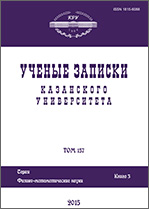|
|
Uchenye Zapiski Kazanskogo Universiteta. Seriya Fiziko-Matematicheskie Nauki, 2011, Volume 153, Book 2, Pages 141–149
(Mi uzku938)
|
 |
|
 |
A disappeared corvid meteor shower
G. V. Zhukova, M. G. Ishmukhametovaab, E. D. Kondratevaa, V. S. Usaninab
a Institute of Physics, Kazan (Volga region) Federal University
b Engelhard Astronomical Observatory, Kazan (Volga region) Federal University
Abstract:
A meteor shower with a radiant in Corvus has been observed once in 1937. Cuno Hoffmeister saw meteor orbits during his southern hemisphere campaign. He recorded 109 slow meteors in the period June 25 – July 2, 1937. The outburst was broad; the radiant was a diffuse. He noticed a rather striking resemblance to the orbit of comet 11P/Tempel–Swift–LINEAR.
New computational capabilities allowed us to carry out more detailed and objective analysis of the orbit of this comet.
The evolution of the comet's orbit was determined taking into account the perturbations from seven planets (Venus–Neptune) within the period from 1940 to 1600. Interesting peculiarities were revealed, on the basis of which ejections from the nucleus in various directions were modeled. It was found that maximum closeness between the comet's orbits and the meteor stream is possible near the year 1808. Models of particles with different ejection rates were calculated; the equations of the comet's motion were integrated for the period from 1808 to 1940. The influence of the ejection point position on the evolution of the model orbits was analysed. Radiant coordinates were calculated for the models and the comet. The possible connection between the comet 11P/Tempel–Swift–LINEAR and the meteor shower with the radiant in Corvus was not confirmed.
Keywords:
meteor showers, comet 11P/Tempel–Swift–LINEAR, asteroid, С. Hoffmeister, radiant, evolution of small bodies in the solar system.
Received: 25.04.2011
Citation:
G. V. Zhukov, M. G. Ishmukhametova, E. D. Kondrateva, V. S. Usanin, “A disappeared corvid meteor shower”, Uchenye Zapiski Kazanskogo Universiteta. Seriya Fiziko-Matematicheskie Nauki, 153, no. 2, Kazan University, Kazan, 2011, 141–149
Linking options:
https://www.mathnet.ru/eng/uzku938 https://www.mathnet.ru/eng/uzku/v153/i2/p141
|

| Statistics & downloads: |
| Abstract page: | 355 | | Full-text PDF : | 118 | | References: | 36 |
|




 Contact us:
Contact us: Terms of Use
Terms of Use
 Registration to the website
Registration to the website Logotypes
Logotypes








 Citation in format
Citation in format 